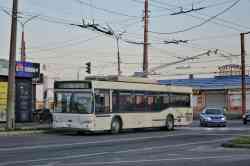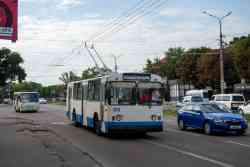 Elektromos városi közlekedés
Elektromos városi közlekedésBila Cerkva
Szerkesztő: Дмитрий Недашковский.
Hírek, események
Gyors járműkeresésFotók vonalankéntTrolibuszok
MapsCity Photo Galleries
Transport communityÚj képekMinden frissítésInformációk
Bila Tserkva is located in Kyiv Oblast, Ukraine. The city’s population is about 205,000 people. Trolleybus service in the city opened on June 23, 1980. The length of the first section was 6.1 km — from Pavlichenka Street to the main gate of the tire plant. The opening was served by 12 ZiU-682V vehicles. By 1984, the line had been extended four more times in both directions, thus forming the city’s central trolleybus route No. 1 from Peremohy Square to the Rotok railway station. In 1989, route No. 2 was opened, connecting the 4th microdistrict (Komsomolskyi residential area, now — Levanivskyi district) with factories and the Rotok station. In the early 1990s, the city had about 85 ZiU-682 vehicles of various modifications. Between 1991 and 1993, 9 articulated trolleybuses of the Kyiv-11 and YuMZ T1 models were delivered. The daily fleet for the 2 routes was 45–50 vehicles. By 1994, a second bridge over the Ros River had been completed, and two routes were launched to the new Tarashchanskyi district: 4 and 5. In October 2004, the last network extension took place — a route was launched connecting the Pishchanyi district with the city center, designated as No. 3. Initially, it was planned to extend this route to the Rotok station before opening. Only in 2014 was route 3a launched, connecting the Pishchanyi district with the Rotok station. Notably, the shorter route No. 3 was not cancelled. The total length of trolleybus lines in single-track measurement is 44 km. By the late 2000s, the trolleybus system was in decline — only 26 vehicles remained in service, with a daily output of up to 11 units on all 5 routes. From 1999 to 2011, only 2 new trolleybuses were purchased. Due to the decline in production and a worsening economic crisis, by 2009 state subsidies for covering concessionary fares became incomplete and extremely irregular. The city budget could no longer subsidize the enterprise on its own, so wage arrears kept growing every month. The situation reached its “peak” in early April 2009, when trolleybus workers lined up their vehicles on the city’s central square for more than 10 consecutive days. Funds were found. Salaries were paid, but the state still failed to provide timely subsidies. By the end of September 2010, wage arrears to the enterprise’s employees exceeded three months, leading to a complete halt in service from October 1 to 12, as no drivers showed up for work. By the end of 2010, the financial situation had stabilized, and positive trends emerged: within half a year, three trolleybuses underwent a full factory overhaul, two received major mid-life repairs, and in July 2011, for the first time since the collapse of the Soviet Union, funds were allocated for the purchase of 6 brand new trolleybuses. Negotiations were held with manufacturers from Lutsk (Bogdan), Dnipro (Megapolis), and Minsk (Belkommunmash, MAZ), and a tender was announced. The winner was LLC “MAZtransservice.” In late November 2011, the first low-floor trolleybus in the city, model MAZ-ETON T103, was delivered. By early February 2012, all 6 purchased Belarusian-made vehicles entered service. During the summer-autumn period, three more vehicles underwent factory overhauls. Fleet deployment on route No. 1 increased to 9–10 vehicles, and on No. 4 — to 2. From 2012 to 2016, all ZiU and YuMZ trolleybuses underwent major overhauls, extending their service life by another 8–10 years. The year 2016 became a turning point in the modern history of Bila Tserkva’s trolleybus system. At the start of the year, all wage arrears had been paid off. In March, the executive committee adopted a program to attract investment for the creation of a unified automated fare payment system — the “Electronic Ticket,” and on July 22 the investment agreement was signed. On December 27, 2016, 4 high-capacity used trolleybuses from Budapest arrived at the depot, as part of the approved electric transport development program. In addition, the first “Electronic Ticket” validator in the city was installed inside one of the enterprise’s trolleybuses. Rules for using the "Electronic Ticket" system: Prospective trolleybus route development scheme: P.S.:
Routes:
Videók
A városban legtöbbet fotózók1.: Дмитрий Недашковский — 844 kép2.: tavalex2007 — 119 kép 3.: Евгений Гура — 56 kép A fotósok teljes listája |
Véletlenszerű kép Új képek     
|
Sötét nézet
A honlapon szereplő képek felhasználása a szerzők hozzájárulása nélkül tilos!.





















